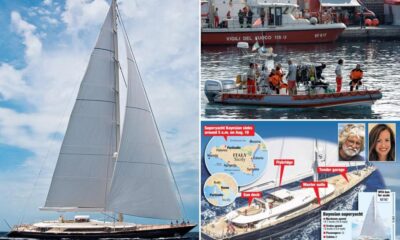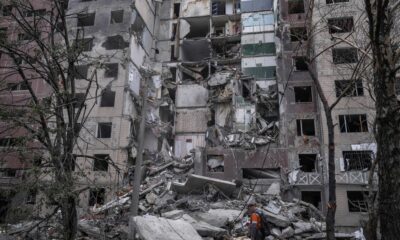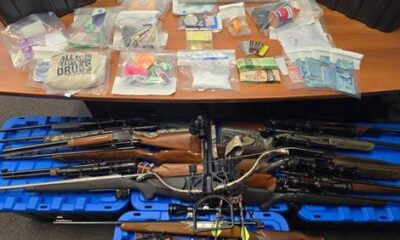Breaking News
Rail dangers ‘more of a concern’ in Winnipeg’s St. Boniface, report finds – Winnipeg

Railway hazards are not uncommon in Winnipeg.
In 2012, a fuel plant fire caused a fireball to erupt above St. Boniface, igniting a tanker in its path.
For Tom Scott, a resident of St. Boniface for 34 years, this incident served as a wake-up call.
“You can witness the rapid damage that can occur. It’s not simply a matter of something going slightly wrong and being easily rectified. It can escalate quickly,” he remarked.
This was not the first rail-related incident Scott had encountered during his time in St. Boniface.

“There has been a derailment here before. Additionally, there have been several other more serious derailments,” he noted.
“It is a growing concern.”
A recent study from the University of Manitoba revealed that 40% of St. Boniface residents are exposed to railway-related hazards.
“The risk of a derailment, especially if the train is transporting hazardous materials, could lead to a spill resulting in a fire necessitating the evacuation or isolation of residents in the vicinity,” stated Ijeoma Eze, one of the researchers.
Eze further explained that over the past decade, the average train length has been increasing by over 27% annually. This poses “heightened delays and safety risks,” particularly for the 26 educational institutions, medical facilities, senior centers, and daycares within 800 meters of the rail lines in St. Boniface.

Get daily National news
Receive the latest news headlines on politics, economics, and current affairs in your inbox daily.
This corresponds to the evacuation and isolation buffer zone recommended by Transport Canada, which Eze believes is inadequate.
“Depending on the severity of the incident, its effects could be felt up to two kilometers away from the site,” she emphasized.
Eze suggests that one potential solution could be the relocation of rail lines, but Matt Allard, the St. Boniface councillor, acknowledged the complexity of this endeavor.
“There are significant negative consequences, including safety issues, convenience, noise levels. On the other hand, there are reportedly 2,000 jobs – well-paying jobs – in Winnipeg,” he acknowledged, highlighting that if it were a simple resolution, it would have been implemented already.
“If we could magically segregate all rail lines from municipalities in Manitoba, maintain employment opportunities, and ensure the smooth flow of goods while meeting the needs of Winnipeg residents, that would be the ideal scenario. However, finding such a solution is challenging,” he remarked.
He made reference to the ongoing rail relocation study being conducted by the provincial government.

However, for Scott, the matter is clear.
“Relocating the rail lines would eliminate the dangers, worries, concerns, health issues, traffic congestion, and pave the way for a healthier lifestyle for everyone,” he asserted.
According to Eze’s study, when rail lines traverse residential areas, residents are susceptible to safety risks, pollution, noise pollution, vibrations, and traffic hazards. This leads to significant social, health, economic, and safety challenges.
These challenges encompass injuries, landscape disturbances, diminished community cohesion, heightened stress levels, increased criminal activities, and decreased property values.
Scott reminisced about a time when St. Boniface did not face these risks to such a severe extent, reflecting on his early years in the neighborhood.
“I can recall a time when train crossings were infrequent. Now, they are a common occurrence,” he observed. “Therefore, it is a growing concern.”
However, Scott clarified that the trains themselves are not the issue. “It’s the contents they transport, their size, and other factors,” he pointed out.
He expressed hope for prompt decisions or actions to address the situation.
“Perhaps we may not be able to completely eliminate all rail lines, but envision having 50% fewer in 20 years. That would be a significant reduction. Even removing two or three rail lines in five years would be a step in the right direction. Progress can only be made if we take the initiative,” he emphasized.
Scott likened the idea of rail relocation from residential areas to personal growth.
“Just as you don’t expect to be the best version of yourself overnight, but strive to be better each day based on what you learn, the city should adopt the same mindset – constantly learning and improving,” he suggested.
“The focus should be on enhancing the quality of life for residents, who contribute through taxes. A community thrives when its residents are valued,” he concluded. “Therefore, let’s strive for improvement for everyone.”

© 2024 Global News, a division of Corus Entertainment Inc.
-

 Destination8 months ago
Destination8 months agoSingapore Airlines CEO set to join board of Air India, BA News, BA
-

 Breaking News10 months ago
Breaking News10 months agoCroatia to reintroduce compulsory military draft as regional tensions soar
-

 Gadgets3 months ago
Gadgets3 months agoSupernatural Season 16 Revival News, Cast, Plot and Release Date
-

 Tech News12 months ago
Tech News12 months agoBangladeshi police agents accused of selling citizens’ personal information on Telegram
-

 Productivity11 months ago
Productivity11 months agoHow Your Contact Center Can Become A Customer Engagement Center
-

 Gadgets3 weeks ago
Gadgets3 weeks agoFallout Season 2 Potential Release Date, Cast, Plot and News
-

 Breaking News10 months ago
Breaking News10 months agoBangladesh crisis: Refaat Ahmed sworn in as Bangladesh’s new chief justice
-

 Toys12 months ago
Toys12 months ago15 of the Best Trike & Tricycles Mums Recommend
























